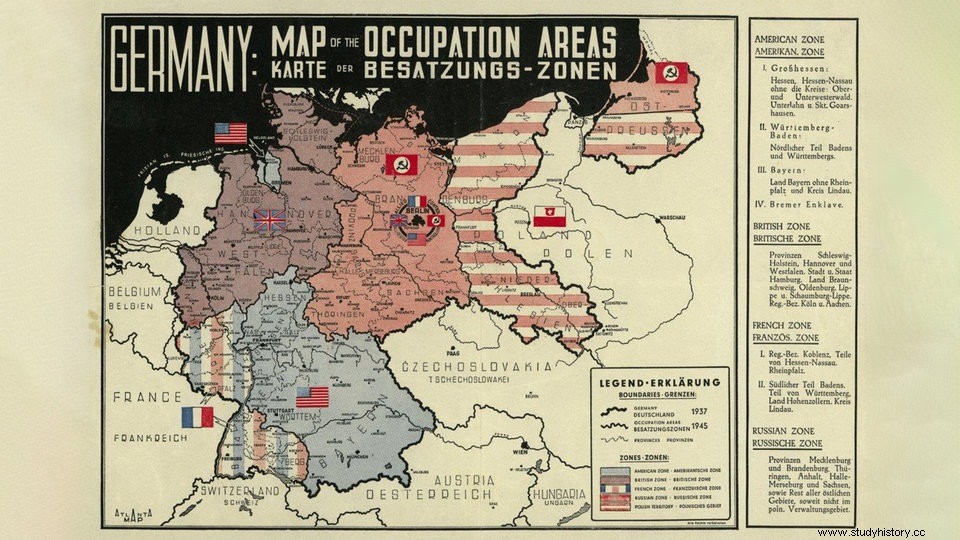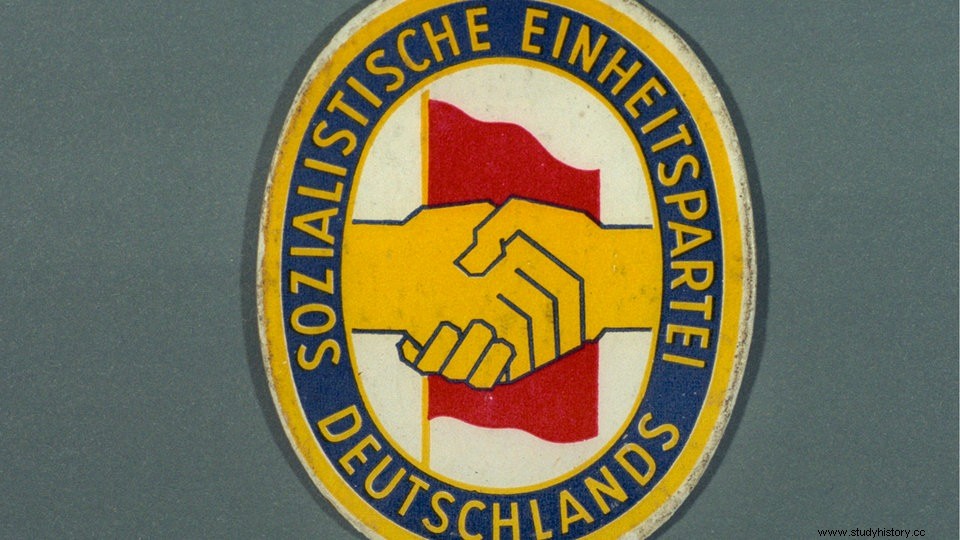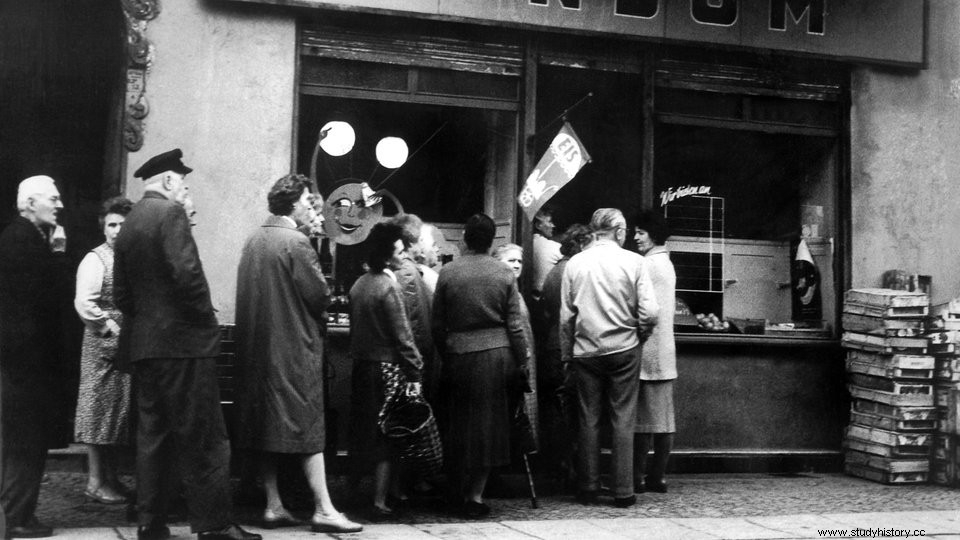For 40 years, the German Democratic Republic (GDR) existed alongside the Federal Republic of Germany (FRG) as the second German state, separated by guarded borders and walls. According to the constitution, all citizens in the GDR were equal. The state took over large parts of private property and nationalized the economy. The principle of socialism applied.
The founding of the GDR
After the end of the Second World War in 1945, the victorious powers France, Great Britain, the USA and the Soviet Union decided to divide German territory into four occupation zones. In addition, each occupying power received a part of the capital Berlin. The goal was to end National Socialism and get the economy going again.
After only two years, the relationship between the Eastern and Western powers was split. Both sides accused each other of wanting to expand their spheres of influence. The West, especially the United States of America (USA), pursued the principle of a capitalist free market economy. The East, the Soviet Union, tried to spread its own communist worldview to the West.
Capitalism and communism - both seemed incompatible. As early as March 1946, British Prime Minister Winston Churchill spoke of an "Iron Curtain" separating West from East. A year later, the United States decided with the Marshall Plan, named after the then US Secretary of State George C. Marshall, to tie the European states closer economically and to curb communism in Europe. The Cold War began.
On October 7, 1949, the Soviet occupation zone (SBZ) officially became the German Democratic Republic (GDR). The area included today's federal states of Mecklenburg-Western Pomerania, Brandenburg, Berlin (eastern part), Saxony-Anhalt, Saxony and Thuringia. The new state continued to have close ties with the Soviet Union, but was now an independent state with its own government and economy.
In 1952, Soviet leader Josef Stalin proposed a reunited, neutral Germany with his "Stalin Note". This was rejected by the western powers, however, on the grounds that Stalin wanted to undermine the West ties of the Federal Republic of Germany. To this day there are differing opinions in the scientific community as to how seriously the Stalin note was meant.

The zones of occupation after World War II (1945 US military government map)
The Soviet Union as a model
The GDR was declared a socialist state based on the Soviet model. This meant, for example, that most private property – especially shops and companies, but also rental houses – became state-owned.
At first it was just the large companies, but when Erich Honecker came to power in 1972, increasingly all the smaller companies were included. Any production of goods and goods was henceforth subject to the state.
Like the economy, GDR politics were also centrally regulated. The ruling party was the Socialist Unity Party of Germany (SED). At the urging of the Soviet Union, this emerged from a forced merger of the German Communist Party (KPD) and the German Social Democratic Party (SPD). Wilhelm Pieck became the first President, Otto Grotewohl Prime Minister.
According to the constitution, four other parties were permitted in addition to the SED:the Christian Democratic Union (CDU), the Liberal Democratic Party of Germany (LDPD), the Democratic Farmers' Party of Germany (DBD) and the National Democratic Party of Germany (NDPD).
Outwardly, it seemed as if each of these parties was pursuing its own political direction. However, they had no party program of their own. All were subordinate to the SED.
Their actual task was to address system-critical citizens - i.e. those who had little to do with the political orientation of the SED. If they instead identified with the smaller parties, the SED indirectly got the support it wanted.
Dictatorial governance
The SED had a strictly hierarchical structure. The lower and middle levels included, for example, district, city and municipal councils. Important offices in the fields of economy, education, culture and security belonged to the party leadership, the nomenklatura. This was the actual center of power in the GDR.
All members of the party had the right to elect the leadership of the SED. However, the nomenklatura determined which candidates were even eligible for the open positions. The members of the lower bodies had neither the opportunity to propose candidates nor to stand as a candidate for election.
The choice was thus possible, but severely restricted. The party also demanded unconditional loyalty to the party from the lower bodies. The members had to agree to the decisions of the management level. Those who resisted were not tolerated within the government.

SED - the all-determining party of the GDR
The citizens of the GDR could hardly influence state policy. There were no free elections. Every eligible voter received a ballot paper with a list presenting the SED candidates. Anyone who submitted an empty form approved all candidates.
It was possible to remove candidates from the list and thus reject them. But very few used it. Anyone who went to the polling booth to process the ballot made themselves suspicious. In this way, the SED put pressure on the voters. Typically, people would simply fold the ballot and cast it. That's why the elections in the GDR were also called "Wrinkles."
The leaders of the party
Erich Honecker and Walter Ulbricht were among the best-known politicians in the GDR. Ulbricht was General Secretary of the Central Committee of the SED from 1950 to 1971, making him the most powerful man in the state. His main concern was to establish and consolidate socialism in the GDR. When more and more people left the country for the West in the early 1960s, Ulbricht had to do something to keep people in the country.
It is true that he wrote the sentence "No one intends to build a wall". The construction of the wall fell during his tenure. In 1971 Ulbricht had to resign because he lacked support within the government.

The leaders of the SED:Walter Ulbricht and Erich Honecker (left)
Honecker replaced Ulbricht. He worked to improve the state's relations with the rest of Europe and the United Nations. Relations with Germany also improved under Honecker. But he stuck to the ideology of socialism.
Despite many reforms, Honecker did not succeed in turning the GDR into a state with a stable economy. Public dissatisfaction grew. Continuing mass protests finally forced Honecker to resign on October 18, 1989.
The nationalized economy
In a free market economy, supply and demand determine the market. It was different in the GDR, here the state regulated the economy. The SED nationalized the industrial and commercial companies.
Farms were collectivized and merged into agricultural production cooperatives (LPG). The State Planning Commission (SPK) drew up five-year plans. The commission recorded how many goods were needed to provide for the GDR citizens.
Based on the five-year plan, the party leadership decided how many raw materials the companies needed for production, how many workers they should employ and how high their wages should be. The price of the end product was also specified.
The companies had to strictly adhere to this economic plan. This restricted the economy, making it less flexible. If consumer behavior changed, the market could only react slowly.
Cheap rolls, expensive pineapple
Many wholesale, retail and catering businesses were in the hands of the state. They were operated by the trade organization (HO) or the consumer cooperative. The state subsidized the food and clothing industries and guaranteed basic supplies at fixed prices.
For example, a roll cost five pfennigs for more than 40 years. No more, no less.
Products from the West and imported goods such as coffee, cocoa and bananas, on the other hand, were more expensive than staple foods and were also less common in shops. Shops like "Delikat" or "Exquisit" offered high-quality luxury items, food and clothing. But the prices for it were high. People sometimes paid 18 marks for a can of pineapple and 150 marks for a shirt.
In Intershops, citizens could buy western goods that were rare in the GDR, including records, gold jewelery and luxury goods. There were no customs duties, customers paid in German marks or other Western European currencies.
Buyers often had to wait several years for luxury items such as electrical appliances and cars. The waiting time for a Trabi was up to twelve years.
Despite careful planning, there were always supply bottlenecks in the GDR. Imported goods such as tropical fruits, cocoa and sugar were often only available in small quantities. People then had to stand in long queues early in the morning and wait to be able to buy them.
It was not uncommon for the goods to be sold out when it was finally their turn. Many therefore bought in advance. Groceries such as bread and meat were also gone shortly after noon here and there.

Queuing was part of everyday life
